Everything You Need to Know Connect Computer to Tv
You're non the offset person who'southward wondered what it would be like to have a giant desktop monitor. Recall of all the multi-tasking and immersive gaming you could manage if you had a 50- or 60-inch monitor instead of a standard 24-inch monitor! Just you've probably noticed that every bit monitors get bigger, they besides tend to get prohibitively expensive.
You've probably already got a big screen in your house, though—a Boob tube. At the end of the day, isn't an HDTV just a giant, living-room-oriented computer monitor?
Non exactly. While you tin can use a TV as a estimator monitor in nearly cases, that doesn't mean information technology'due south the all-time option. In fact, it'south likely less attractive, convenient, and usable than you think (not to mention, probably not that inexpensive). There'southward a reason clay-cheap 32-inch HDTVs aren't flying off the shelves to exist used as budget-friendly jumbo screens.
You definitely can employ an HDTV equally your PC's display, though, and your television can also work in a pinch if you suddenly need a second screen. Hither'south everything you need to know about how to set up a Television set as a computer monitor—and why you lot might non want to.
Will it even work?
The short answer: Yes. Y'all may need a special cable, depending on your PC's outputs and your HDTV's inputs, and yous'll need to cheque a couple of settings, but you shouldn't have too much problem hooking most modernistic PCs upward to nearly mod HDTVs.
Modern HDTVs have HDMI outputs. Some older HDTVs accept DVI inputs, and some even have VGA inputs specifically designated for "PC use." If your graphics card has an HDMI output, you're practiced to go: Just use an HDMI cable to connect your PC to your HDMI.
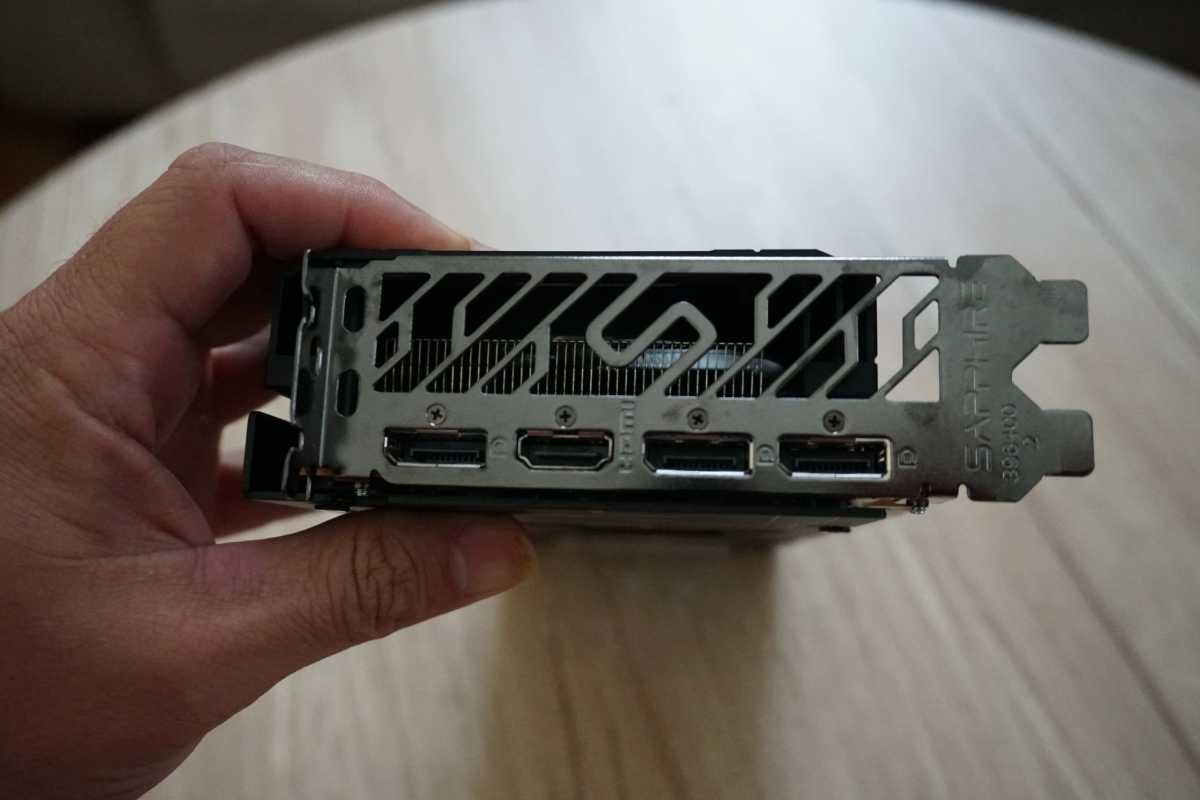
All modernistic graphics cards (like this Sapphire Pulse Radeon RX 6600 XT) include at least one HDMI port (second from left, between several DisplayPorts).
Brad Chacos/IDG
If you're using an older graphics card or motherboard that only has a DVI output, you can snag a inexpensive DVI-to-HDMI cable and plug it into your HDTV's HDMI output. Amazon sells a six ft. AmazonBasics version for just $sevenRemove non-product link. Although some older HDTVs and some older computers simply accept VGA inputs/outputs, they aren't not an ideal option. VGA's an analog signal that will give you a far fuzzier, lower-resolution epitome than you lot'll get with an HDMI or DVI cord.
If y'all want to use your HDTV as a 2nd or third monitor, you may need to apply a dissimilar port, such every bit your graphics menu's DisplayPort output. In this case, you'll need to use a unlike cable (DisplayPort-to-HDMI). The chief advantage to using the DisplayPort output instead of DVI or VGA is that HDMI and DisplayPort carry both video and audio signals. A DVI-to-HDMI cable can transmit both video and sound if your graphics card supports HDMI audio via DVI—unlikely if it doesn't take any HDMI ports—while VGA merely transmits video. If you use DVI or VGA, you volition nigh likely need to connect your PC's audio up to the HDTV separately, or apply external speakers or a headset.
Bottom line? Endeavor to stick to HDMI if or DisplayPort-to-HDMI connections if it's possible. It'southward the easiest solution.
Getting your PC ready
Yous'll also need to make up one's mind whether your graphics card (or your PC's integrated graphics) is capable of outputting at the resolution of your HDTV. To do this, you will first demand to find the resolution of your HDTV by consulting the manufacturer's manual. Some HDTVs have non-standard resolutions; it's not a given that your HDTV will be supported.Moststick to standard 720p, 1080p, or 4K resolutions however. Adjacent, detect the maximum resolution your graphics card/integrated graphics supports.
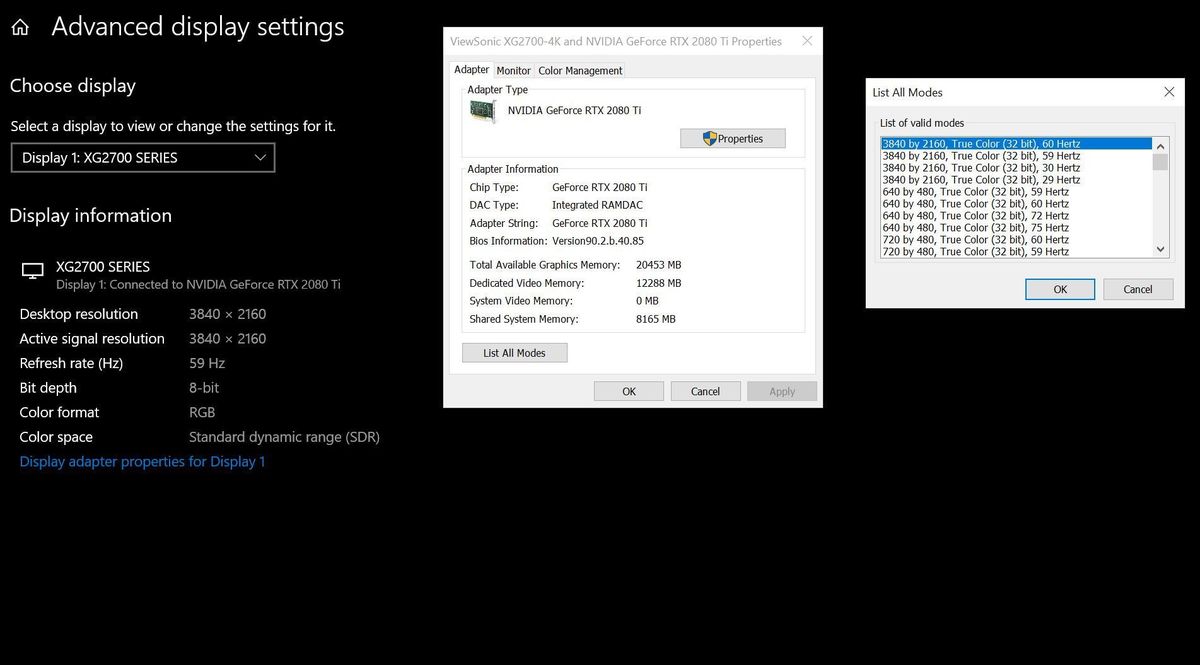
Open the Windows x Get-go bill of fare and head to Settings > System > Display > Advanced display settings > Brandish adapter properties for Display one. In the window that pops up, click List All Modes. Discover the resolution that matches your HDTV's resolution and select it.
If yous're using the HDTV to supplement a standard computer screen, but follow our guide on how to set up upwardly two monitors to tell Windows how to manage both displays.
Will it await good? Maybe. It depends on how you lot're using your HDTV.
HDTV features to keep in mind
If you're turning your HDTV into a PC-backed multimedia powerhouse, and you program on using information technology primarily as a television and streaming hub—e.g. a screen you'll go along to view from several anxiety away—it will probably look fine. But if you're trying to stick a sixty-inch HDTV on a desk-bound, you're more likely to end up with headaches and eye strain.
There are a few different factors to continue in mind if you lot want to use an HDTV as a computer monitor.
Pixel density
Pixel density, or the number of pixels packed into one square inch of screen (measured in pixels per inch or ppi), is the almost of import factor to consider. A 15.6-inch laptop screen with a 1920 x 1080 resolution has a pixel density of 141.21ppi, while a 32-inch HDTV screen with the same resolution has a significantly lower pixel density of 68.84ppi. The lower the pixel density, the less clear and detailed the image becomes.
But the importance of pixel density decreases with viewing altitude. The further yous sit from a screen, the lower the pixel density need to be for y'all to have a comfy viewing experience. You won't have whatsoever problems looking at a 15.vi-inch/141.21ppi screen from ii feet away, but you will observe it much harder to view a 32-inch/68.84ppi screen from the same distance. This is why a "Retina" screen on the iPhone has a pixel density of 326ppi, just a "Retina" screen on the Macbook Pro has a pixel density of just 226ppi.
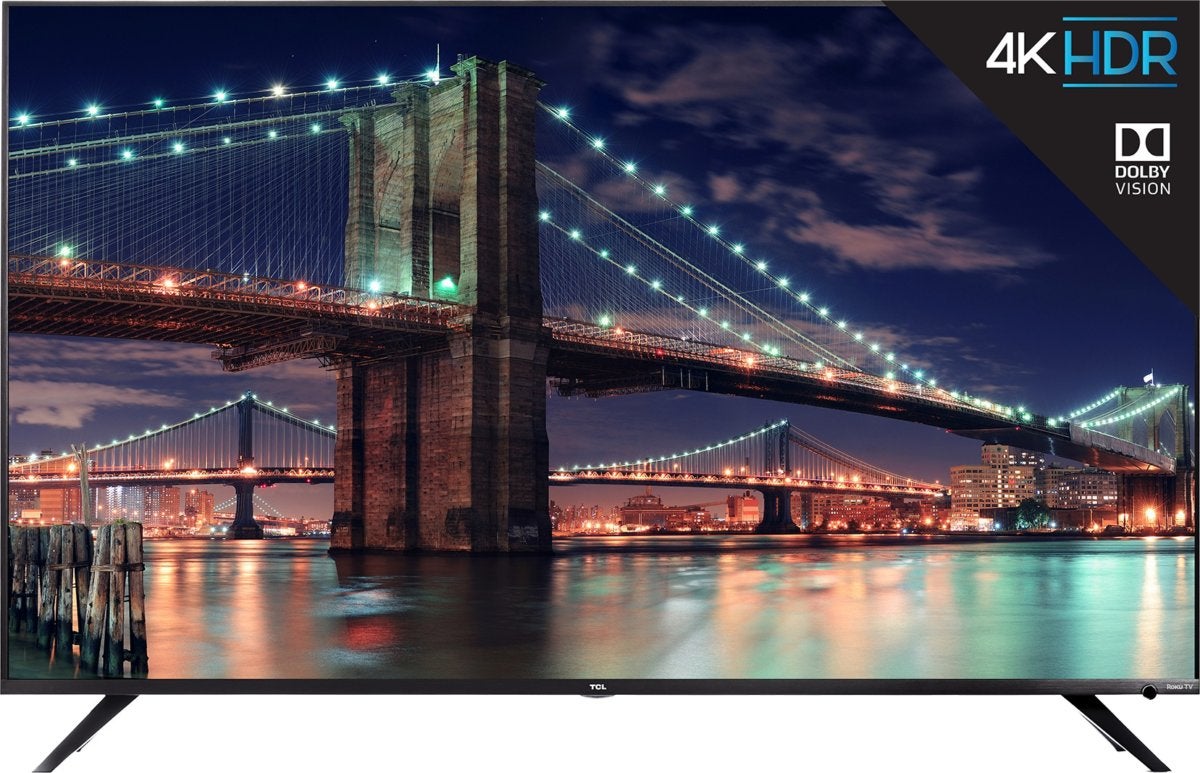
6 Series TCL TV.
A normal user typically sits between two and three feet away from a desktop monitor. To comfortably view a monitor at this distance, you lot should aim for 80ppi or higher. This means that for 1920×1080 (1080p) resolution, your screen should be no larger than 27.five inches diagonally, and for 4K sets, yous'll want to max out at 55 inches, like the $700 TCL 6-series 4K UHD quantum dot Boob tube shown above. Information technology's our favorite bang-for-buck HDTV.
Important: "4K" is not a market standard. A 4K HDTV can mean 4x720p (3840×2160 resolution) or 4x1080p (4096×2160 resolution). Nearly models utilise 3840×2160, but you should check the exact specs of your model to make up one's mind pixel density.
Input lag
Input lag is the delay betwixt movement you make on your input device (in this case, a mouse and keyboard) and what displays on your screen. While most estimator monitors prioritize minimal lag times, HDTVs generally do non—they prioritize (laggy) video processing instead. These actress milliseconds may not seem like they matter, but they volition make a massive divergence if you're trying to do something like competitive online gaming.
DisplayLag maintains a proficient database of input lag times, sortable by display blazon. An input lag of less than xxx milliseconds is considered skillful for an HDTV if you lot're using it as an HDTV. For a computer monitor, you'll want to aim for less than 20 milliseconds, and the lower you lot can go, the better.
Response fourth dimension
Ofttimes confused with input lag, response time describes how long it takes for a display'south pixels to switch colors between scenes. HDTVs and figurer monitors can have very different response times. HDTVs tend to prioritize richer colors, higher dissimilarity, and wider viewing angles—all of which lend to a longer response time. Calculator monitors tend to driblet some of the image processing and viewing angles for faster response times. If you utilise a display with a slower response time, yous may see "ghosting" in fast-paced video and gaming sequences.
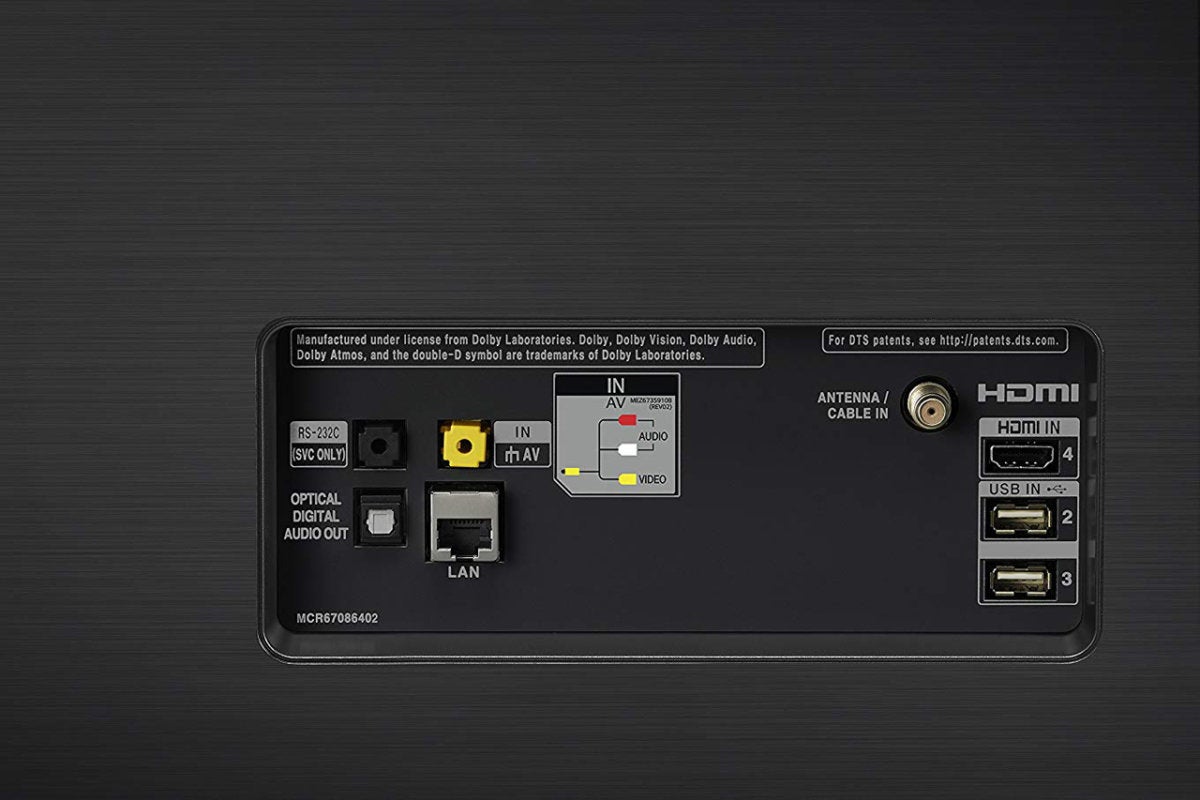
Also pay attention to the type and number of ports. This is but one of two port areas on an LG TV. Many TVs offering ports nearer the side also for the sake of easy admission.
Some HDTVs take a "game mode" setting, which cuts some of the prototype processing to amend both input lag and response time. If y'all plan to play PC games on your Boob tube, definitely dig around in your HDTV'due south options to see if information technology has this feature.
Refresh rate
Some other factor that may bear on performance is a brandish'due south refresh rate. Refresh rate is the number of times a display "refreshes," or re-draws, its image each second. Most modern displays have a refresh rate of 60Hz, which means they refresh their image 60 times per second. Simply y'all've probably also seen higher-end gaming monitors and HDTVs with higher advertised refresh rates—120Hz, 144Hz, or even 240Hz. This tin be misleading, however, because a computer monitor with a 120Hz refresh rate may non be the same as an HDTV with a 120Hz refresh rate.
The reason for this is because the content people lookout man on a television is produced at either 24fps, 30fps, or 60fps. The content people view on a estimator monitor can be very different—many games tin output frame rates higher than 60fps if you have a powerful enough graphics menu.
An HDTV with a high advertised refresh rate may use mail-processing applied science to achieve that charge per unit, such equally past creating additional frames to upscale content, or past calculation black frames between each frame to forestall image blur. The good news is that this probably won't make a divergence if y'all're not playing PC games at very fast frame rates. But if you accept a PC designed for the best possible gaming experience, hooking up an HDTV instead of a computer monitor likely means that you're not getting the most out of your machine.
Is it worth information technology?
There's no damage trying to connect your computer to a Tv you already ain to see if it works for you. Get for it!

Our advice varies if y'all're shopping though. If you're looking to get the best bang for your buck, an HDTV isn't necessarily going to save yous money over a monitor. In fact, if y'all're purchasing a new brandish, I recommend sticking with the tried-and-true computer monitor. For ane thing, smaller, cheaper HDTVs are typically 720p resolution, not 1080p, while similarly priced monitors will about always be 1080p. Then if you're looking for something under 27 inches, an HDTV volition probably be more than expensive and lower-resolution.
These lower-priced 1080p monitors ofttimes support AMD's FreeSync adaptive sync technology as well, which can help your games look buttery smooth. You won't find that in a inexpensive Telly.
If you're looking for something larger than 27 inches, call up that pixel density decreases significantly with every few inches yous gain, and there's a reason HDTV-makers suggest sitting several feet away from their displays. If you need a display that will multitask as an up-close piece of work/email brandish also as a film/amusement brandish, you'll want something with a high plenty pixel density that text won't be a pain to read—and even with a high pixel density, a large display may all the same cause heart and neck strain if you sit too close to it.
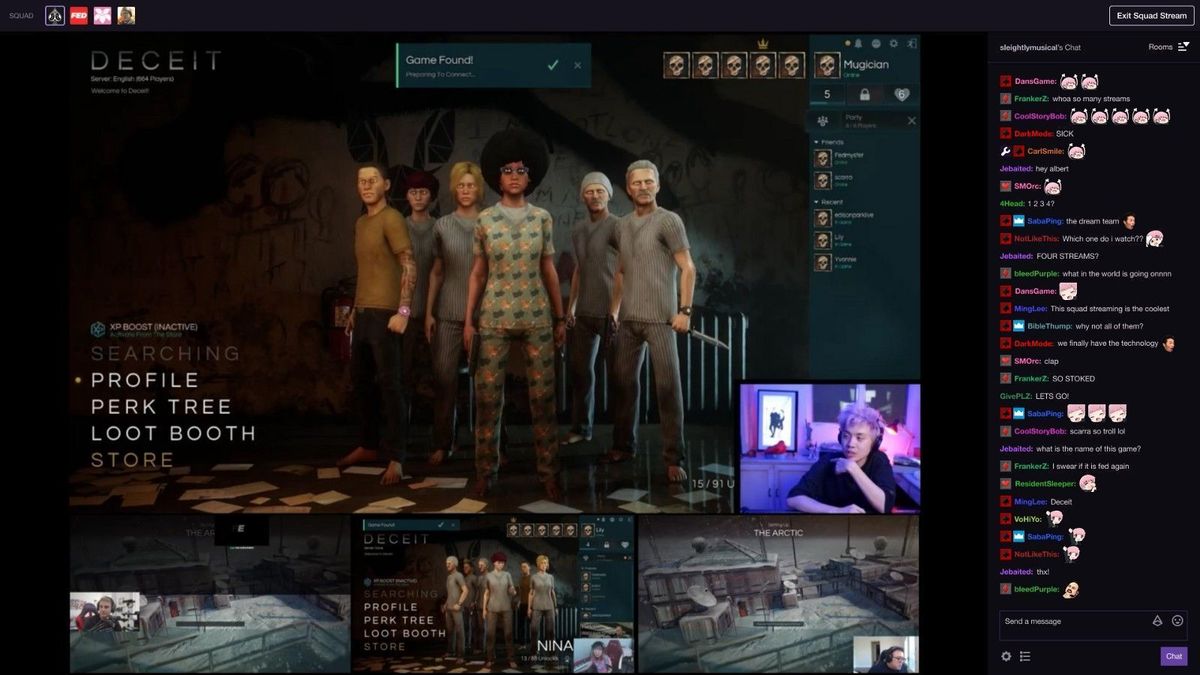
An HDTV as a secondary monitor is perfect for streaming Twitch, watching Netflix, or keeping an middle on Twitter in real fourth dimension.
At that place is an platonic state of affairs in which the HDTV-as-monitor shines, though.
If y'all desire to add together an extra brandish to a single- or multi-brandish setup for entertainment—say, then you can lookout man Netflix or Twitter while you lot write articles, or so yous can play Skyrim on a 60-inch screen—then an HDTV tin can be a very capable (and cool!) monitor replacement. Bonus points if yous happen to accept an extra HDTV lying around, or if you lot can pick i up for dirt cheap.
Note: When you buy something later clicking links in our articles, we may earn a small-scale committee. Read our affiliate link policy for more than details.
Source: https://www.pcworld.com/article/427564/use-your-tv-as-a-computer-monitor-everything-you-need-to-know.html
Enregistrer un commentaire for "Everything You Need to Know Connect Computer to Tv"